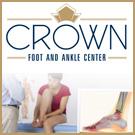Even things you may not be able to feel on your feet or ankle can be dangerous. Most skin cancers are painless, but if you notice cracking, bleeding, or ulceration, contact Crown Foot and Ankle Center 859-317-9019
What is a Bunion?
A bunion is commonly referred to as a “bump” on the joint at the base of the big toe—the metatarsophalangeal (MTP) joint—that forms when the bone or tissue at the big toe joint moves out of place. The toe is forced to bend toward the others, causing an often painful lump of bone on the foot. Because this joint carries a lot of the body's weight while walking, bunions can cause extreme pain if left untreated.
The symptoms of a bunion include the following:
•Development of a swelling, callus or firm bump on the outside edge of the foot, at the base of the big toe
•Redness, swelling, or pain at or near the MTP joint
•Development of hammertoes or calluses under the ball of the foot
•Corns or other irritations caused by the overlap of the first and second toes
•Restricted or painful motion of the big toe
When to Visit a Podiatrist:
If pain persists, podiatric medical attention should be sought. Bunions tend to get larger and more painful if left untreated, making non-surgical treatment less of an option.
We should all still abide by social distancing, but there are still conditions of the foot and ankle that require attention from a Podiatrist right away. One of those conditions is a diabetic ulcer, which could become infected.
A diabetic foot ulcer is an open sore or wound that occurs in approximately 15 percent of patients with diabetes and is commonly located on the bottom of the foot. Of those who develop a foot ulcer, 6 percent will be hospitalized due to infection or other ulcer-related complication.
Diabetes is the leading cause of non-traumatic lower extremity amputations in the United States, and approximately 14-24 percent of patients with diabetes who develop a foot ulcer will require an amputation. Foot ulceration precedes 85 percent of diabetes-related amputations. Research has shown, however, that development of a foot ulcer is preventable.
Should you keep your post-op appointment even in light of stay-at-home orders? Yes! These treatments are critical to identify potential complications and help ensure your full recovery.
We at Crown Foot and Ankle Center are taking every precaution during the Covid-19 pandemic to keep our patient's safe.
Your feet must last a lifetime, and most Americans log an amazing 75,000 miles on their feet by the time they reach age 50. Regular foot care can make sure your feet are up to the task. With proper detection, intervention, and care, most foot and ankle problems can be lessened or prevented.
Problems with your heel can be a real pain! Do you experience a sharp pain in your heel after a walk around the neighborhood or a home workout? You may be experiencing plantar fasciitis. Heel pain is never okay. Schedule an appointment to get back to a healthy life.
Did you know that bunions are 10 times more common among women than men? Contrary to popular belief, it’s not necessarily your footwear that causes the problem (although pointy toes and high heels can contribute). Instead, certain foot types are genetically predisposed to developing a bunion. If you notice swelling, redness, or a callus forming at the base of your big toe, visit your podiatrist today to seek treatment.
American Podiatric Medical Association (APMA)
March 5 at 1:30 PM ·
As winter weather breaks you may be eager to hike or go for a run around your neighborhood. If your workout leaves you with pain and discomfort in the ball of the foot or back or your heel, bursitis may be the problem. Check out our site for tips on this condition and speak with your podiatrist to seek treatment.
https://www.apma.org/bursitis
You know you’ve done it: bathroom surgery. It may be tempting to tackle that ingrown toenail on your own at home, especially during the pandemic. But taking foot care into your own hands can lead to dramatic complications for people with diabetes, including amputation, sepsis, and even death. Leave it to the professionals and keep up with your regular medical care.
American Podiatric Medical Association (APMA)
January 22 at 1:30 PM ·
Tempted to cram your toes into that beautiful pointed shoe? Tight or narrow shoes can lead to pressure on the joints in your toes and cause a hammer toe to form. Hammer toes can be painful, especially if they rub against your footwear. If not treated promptly, the bending of the joint could become rigid and require surgery. Any sign of toe pain or bending in the joints means it’s time to see your podiatrist. (Link) https://www.apma.org/hammertoes
Have you recently started or increased your daily walking routine? Without proper precautions, your dedication to your New Year’s resolution may lead to heel pain and plantar fasciitis. If you are experiencing heel pain, speak with your podiatrist to understand your treatment options for an active, healthy life.
American Podiatric Medical Association (APMA)
March 9 at 4:15 PM ·
The first step to a better run? The right shoes for your specific foot type. Check out tips on selective the right running shoe for you. https://www.apma.org/runningshoes



